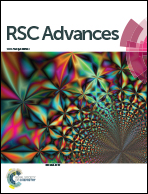One-step synthesis of trimetallic Pt–Pd–Ru nanodendrites as highly active electrocatalysts†
Abstract
Precise control over composition and structure is highly important for designing highly active nanostructured electrocatalysts. Herein, we report a one-step strategy to directly synthesize trimetallic Pt–Pd–Ru nanodendrites in an aqueous solution at room temperature. These newly designed nanodendrites exhibit superior catalytic activities for both methanol oxidation reaction (MOR) and oxygen reduction reaction (ORR) in comparison with bimetallic Pt–Pd nanoflowers and commercially available Pt/C catalysts.


 Please wait while we load your content...
Please wait while we load your content...